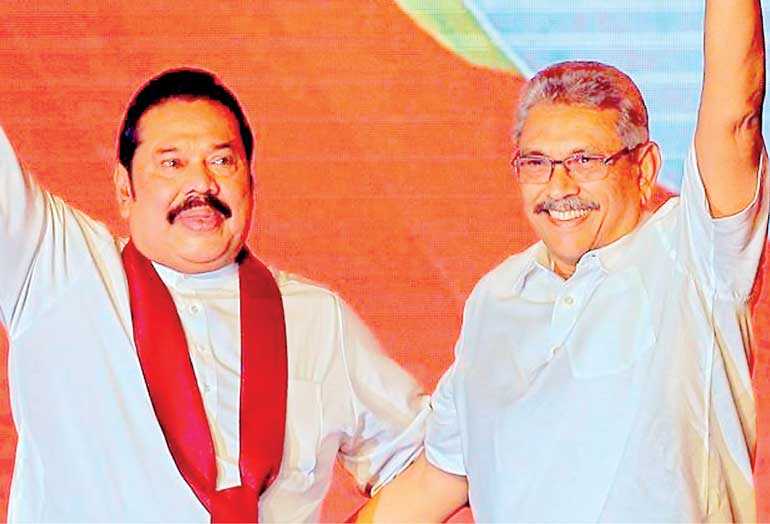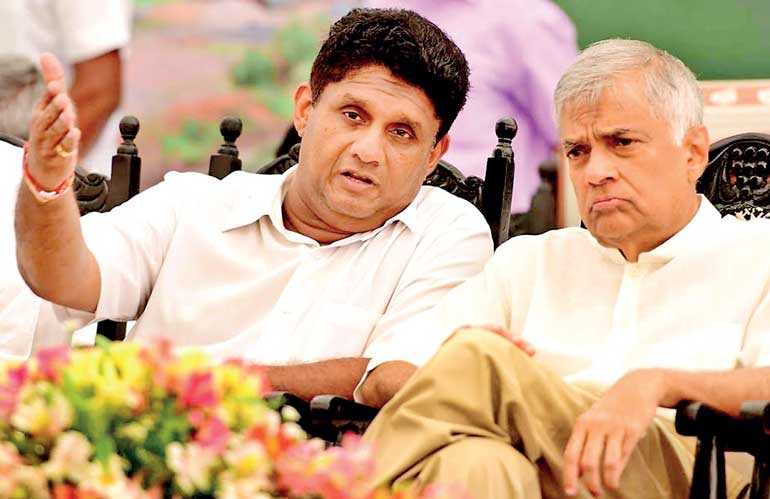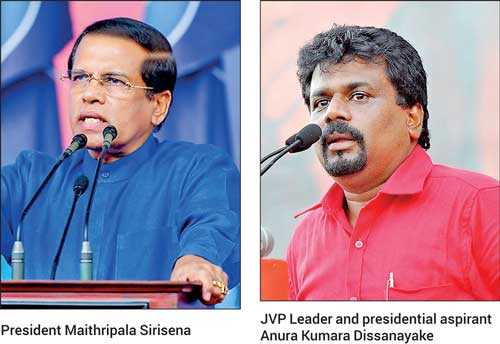Tuesday Apr 22, 2025
Tuesday Apr 22, 2025
Tuesday, 17 September 2019 00:00 - - {{hitsCtrl.values.hits}}

Former President Mahinda Rajapaksa with presidential aspirant Gotabaya Rajapaksa

UNP Leader Ranil Wickremesinghe with UNP Deputy Leader Sajith Premadasa
By Srimal Fernando and Mizly Nizar
Sri Lanka’s major political parties are gearing up to contest the forthcoming Presidential Elections at the tail end of this year.
The new leadership in 2020 and the political party that comes into power taking over the reign of the nation for the next five years should have a clear Foreign Policy vision in their election manifesto. The external policies of the country will define its internal stability given its strategic geographic location in the Indian Ocean. A strong foreign policy doctrine will enable Sri Lanka to overcome external shocks.
Strong economic diplomacy with well thought out policies are imperative to increase foreign currency inflows and the production capacities of the island nation. This requires collective political will and leadership to transform not merely the island nation but to also benefit the neighbouring nations in South Asia.
In the South Asian region, Sri Lanka plays an important role not only as a maritime hub but also as a future oil producing country. As such, the nearest nations like India and Maldives will benefit due to their proximity. 
In taking forward Sri Lanka’s economic diplomacy beyond 2020, the island nation should look to boost its economic ties with its closest neighbour, India which has a massive economy of $ 2.5 trillion and a consumer market of 1.3 billion people. There is much scope to double Indo-Sri Lanka bilateral trade to $ 10 billion in the next five years from the current value of $ 5.2 billion. In addition to trade, a strong fisheries policy is important to resolve the maritime issues between the two nations.
Bordering India is Bangladesh, an emerging nation with one of the fastest growing economies. Tapping into its natural gas resources and ship building is a farsighted economic activity that Sri Lank can further explore in the coming years.
In the South Asian region, Sri Lanka also has very close ties with Maldives and is second home to around 30,000 Maldivians. Both nations are yet to explore the possibilities of tapping into each other’s Exclusive Economic Zone (EEZ) to harness their ocean resources. The two island nations also need to elevate their diplomatic ties to a strategic partnership that provides security guarantees for the each other.
China has been the other important Asian player in Sri Lanka’s economy in the last decade having invested nearly $ 24 billion in massive economically important projects while providing loans of over $ 8 billion.
As India and China are both emerging powers, it is important for Sri Lanka to map out how it balances its stance between these two powerful Asian nations in its future foreign policy doctrine.
Moving beyond Asia, the European Union and the United states play a significant role in Sri Lanka’s economy as trading partners. Almost 55% of the country’s exports, mainly apparels are absorbed by the EU and the US. Sri Lanka earns over $ 4 billion only from apparel exports to these markets. The EU’s Generalised System of Preferences (GSP) + has provided significant benefit to Sri Lanka’s exports to the EU through reduced or nil taxes. However, with Sri Lanka graduating to the Higher Middle Income Status (HMIS) in 2019, it will have to look beyond GSP +, as the country will not qualify for this benefit if it maintains HMIS for the next three years.
Hence, in the next five years the nation should look to transform itself into a Newly Industrialised Country (NIC). This requires a push towards upgrading scientific and technological skills of the local labour force. Reaching the NIC status would provide the environment for foreign manufacturing companies such as the EU automobile industry to invest in joint ventures in Sri Lanka while the finished products could be re- exported to the larger markets in Asia.
With Sri Lanka’s vital geographical position in the Indian Ocean and with proper coordination efforts there are opportunities for economic integration between Sri Lanka, Australia and the Association of Southeast Asian Nations (ASEAN). Such linkages could provide low cost outsourcing prospects for Australian investors in the Asian region. Providing a tremendous boost to the Sri Lankan economy is the Middle Eastern region where over 90% of the country’s approximately two million migrant workers are employed.
In 2017 alone worker remittances from this region stood at $ 7.2 billion, the second largest earner of foreign exchange to the country. The Middle East is also a strong trading partner of Sri Lanka. Nearly half of the island nation’s tea exports are absorbed by the Middle East while almost 90% of the country’s oil requirement is imported from Iran. It is hence of invaluable importance that Sri Lanka continues to maintain strong diplomatic ties with this region.
Apart from these regional blocs, the Commonwealth of Independent States (CIS) including Russia is vital for Sri Lanka as an important export destinations of tea, absorbing the second largest volume of the country’s total tea exports.
Increasing Sri Lanka’s diplomatic foot print in the 52 nation African continent is another area to explore in the coming years. Accessing Africa’s untapped 300 million upper middle income tourism market could provide tremendous scope to boost Sri Lanka’s economy in the future years.
For political stability in 2020 and beyond it is important for Sri Lanka to have a robust foreign policy doctrine along with well aligned and sound domestic policies. For internal stability and security, policy makers should foster peace building and reconciliation while carving out a creative well thought out foreign policy agenda to pursue the country’s external goals.
While maintaining sound diplomatic links in the region, strengthening ties with the US and the West including the Vatican and Scandinavian countries is important to bring global recognition, international attention and hope to the small South Asian island nation. Such ties will also strengthen the country’s position at the United Nations and the World Bank. Hence it is vital that the new leadership clearly sets out the country’s position towards the region and the Western nations to ensure that the country is able to achieve its foreign policy goals beyond 2020.
(Srimal Fernando is a Doctoral Fellow at Jindal School of International Affairs (JSIA), India and a Global Editor of Diplomatic Society for South Africa. He won the 2018/2019 Best Journalist of the year award in South Africa. Mizly Nizar is a foreign policy analyst and a former visiting lecturer at The Bandaranaike Centre for International Studies and the Open University of Sri Lanka.)
Discover Kapruka, the leading online shopping platform in Sri Lanka, where you can conveniently send Gifts and Flowers to your loved ones for any event including Valentine ’s Day. Explore a wide range of popular Shopping Categories on Kapruka, including Toys, Groceries, Electronics, Birthday Cakes, Fruits, Chocolates, Flower Bouquets, Clothing, Watches, Lingerie, Gift Sets and Jewellery. Also if you’re interested in selling with Kapruka, Partner Central by Kapruka is the best solution to start with. Moreover, through Kapruka Global Shop, you can also enjoy the convenience of purchasing products from renowned platforms like Amazon and eBay and have them delivered to Sri Lanka.
Discover Kapruka, the leading online shopping platform in Sri Lanka, where you can conveniently send Gifts and Flowers to your loved ones for any event including Valentine ’s Day. Explore a wide range of popular Shopping Categories on Kapruka, including Toys, Groceries, Electronics, Birthday Cakes, Fruits, Chocolates, Flower Bouquets, Clothing, Watches, Lingerie, Gift Sets and Jewellery. Also if you’re interested in selling with Kapruka, Partner Central by Kapruka is the best solution to start with. Moreover, through Kapruka Global Shop, you can also enjoy the convenience of purchasing products from renowned platforms like Amazon and eBay and have them delivered to Sri Lanka.